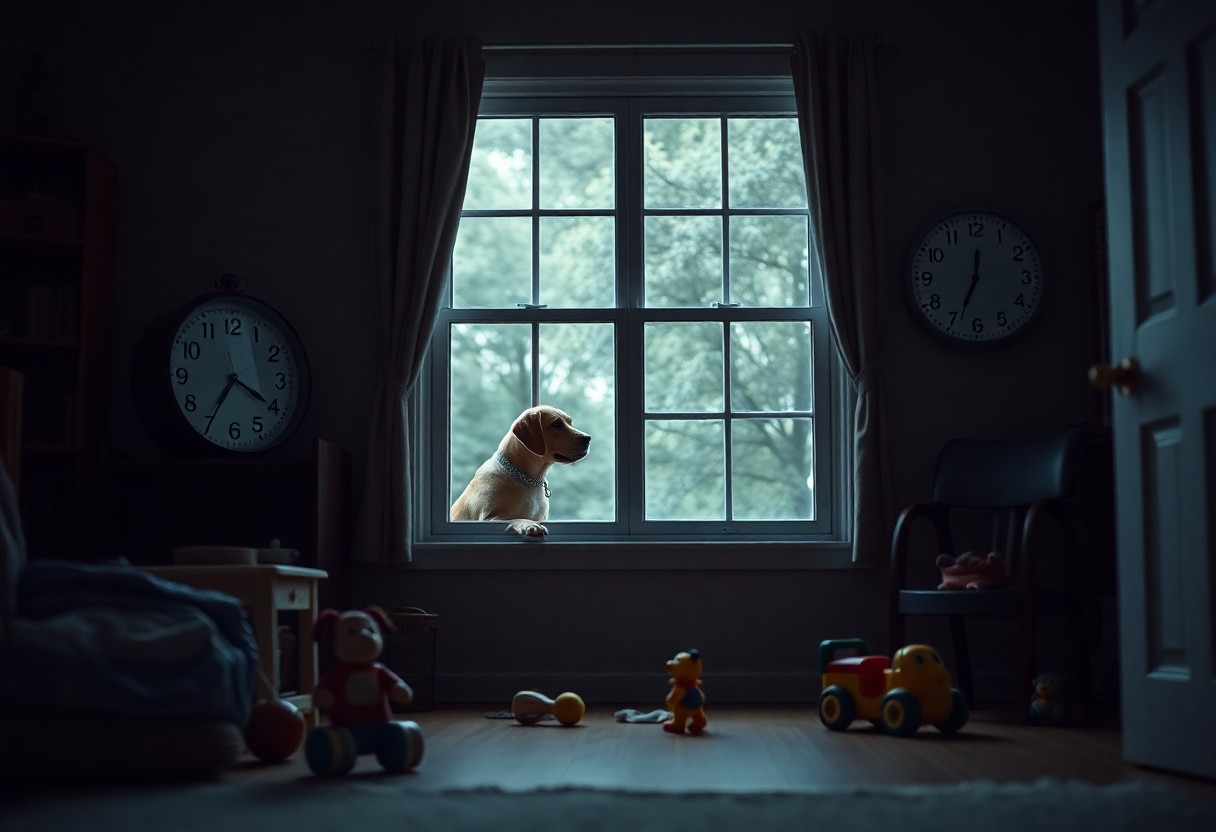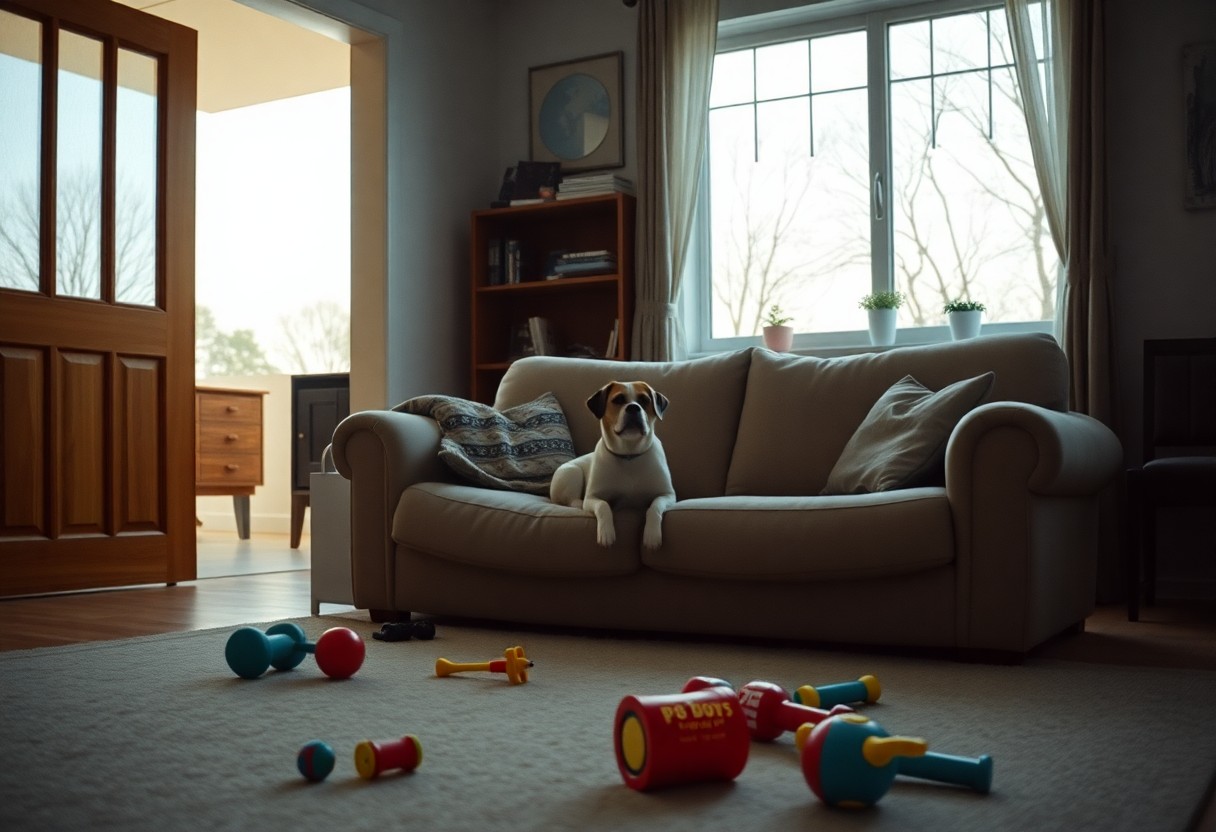Most dog owners have to leave their pets alone occasionally, but understanding the effects of leaving your dog alone all day is important for their well-being. When you leave your dog unattended for long periods, it can impact their mental and physical health, leading to issues such as anxiety, boredom, and destructive behavior. Knowing these effects helps you make informed decisions to ensure your dog’s happiness and safety while you’re away, making it vital to consider how your absence affects their daily routine and emotional state.

Key Takeaways:
- Dogs left alone for extended periods may experience anxiety, stress, or behavioral issues like excessive barking or destructive chewing.
- Lack of interaction and exercise during the day can lead to boredom and potential health problems, including obesity.
- Providing mental stimulation, exercise before and after alone time, and safe toys can help reduce negative effects when the dog is alone.
The Psychological Impact of Loneliness on Dogs
Leaving your dog alone for extended periods can trigger loneliness that profoundly affects their mental well-being. Dogs are social animals that thrive on interaction; the absence of companionship may cause boredom, frustration, and even depression. Studies show dogs left alone for more than 4-6 hours risk behavioral issues and reduced cognitive function. To explore practical guidelines on this, you might find this resource insightful: How Long Can You Leave A Dog Alone?
Signs of Separation Anxiety
If your dog exhibits excessive barking, destructive behavior like chewing furniture, or attempts to escape the house when left alone, these may be signs of separation anxiety. Other indicators include pacing, drooling, salivating excessively, and even self-injury. These behaviors often escalate with time and can impact not only your dog’s emotional state but also your home’s condition. Noticing these responses helps you intervene early and adjust their alone-time accordingly.
Long-Term Emotional Consequences
Extended loneliness can lead to chronic stress, which impairs your dog’s ability to learn new commands or respond to training. Over months, this isolation might cause depression, diminished social skills, and even aggression when you return. The root of these changes lies in altered brain chemistry, particularly decreased serotonin levels, which directly influence mood stability and impulse control.
Persistent loneliness impacts your dog’s emotional health on a neurological level. Continuous exposure to stress hormones such as cortisol can disrupt neural pathways related to emotional regulation, leading to heightened anxiety and withdrawal. Dogs experiencing these effects often show decreased enthusiasm for play and social interaction, which further exacerbates emotional distancing. Long-term, this cycle compromises quality of life and responsiveness to your companionship, turning simple reunions into challenging interactions.
Physical Health Concerns from Extended Isolation
Your dog’s physical well-being suffers when left alone too long, as inactivity and stress weaken their immune system and increase vulnerability to illness. Without regular walks or play, muscles can atrophy and joints stiffen, leading to discomfort or even chronic issues. Additionally, the absence of timely bathroom breaks can cause urinary tract infections or digestive problems. Understanding what are the consequences of leaving a dog alone all day helps you take steps to mitigate these health risks.
Potential for Obesity and Lack of Exercise
Dogs confined indoors without regular exercise tend to gain weight quickly, as their calorie intake remains unchanged while activity drastically drops. This sedentary lifestyle contributes to obesity, increasing risks of diabetes, heart disease, and joint problems. Over time, the lack of stimulation may cause your dog to become lethargic and less interested in physical activity, perpetuating the cycle and exacerbating health issues.
Risk of Developing Destructive Behaviors
Extended isolation often leads dogs to develop destructive habits like chewing furniture, excessive barking, or digging, as a response to boredom, anxiety, or pent-up energy. Such behaviors not only damage your home but also indicate that your dog’s mental and physical needs are not being met.
When your dog is left isolated for hours without engagement, frustration can build and manifest through persistent chewing or scratching, sometimes even self-harm. Dogs may target anything within reach, from shoes to door frames, driven by instincts to alleviate boredom or stress. In some cases, destructive tendencies escalate into obsessive-compulsive behaviors requiring professional intervention. Addressing these signs early with interactive toys, exercise, and social interaction prevents habits that are difficult to reverse and safeguards your dog’s overall well-being.
The Social Dynamics Altered by Neglected Companionship
Dogs left alone all day experience shifts in social dynamics that ripple through their daily interactions. Without regular engagement, their ability to read social cues diminishes, potentially leading to misunderstandings with both humans and other animals. The absence of companionship can skew their natural social rhythm, making them either overly clingy when you return or progressively withdrawn. This altered social balance often reflects in behavioral changes, impairing your dog’s emotional adaptability and overall quality of life.
Impacts on Dog’s Relationship with Humans
Your dog’s relationship with you and others may sour when left unattended for long hours. Inconsistent interaction can foster insecurity, making them either overly dependent on your presence or distrustful when you finally do spend time together. This can result in clinginess, excessive barking for attention, or even aggressive behaviors stemming from frustration and anxiety, ultimately disrupting the bond you’ve worked to build.
Effects on Socialization with Other Animals
Limited exposure to other animals during prolonged solitude hampers your dog’s social skills, leaving them anxious or reactive around peers. Without regular playdates or casual encounters, they may struggle with normal communication behaviors, such as reading body language or sharing space. This deficit can lead to territorial aggression or fear responses that complicate walks and visits to dog parks.
Further compounding the issue, a dog deprived of social interaction with peers misses vital learning opportunities during critical developmental windows. Studies show that dogs with inadequate socialization often exhibit heightened stress markers, like increased cortisol levels, during new encounters. This biological response indicates a repressive effect on their ability to comfortably integrate into settings with other animals. Consequently, these dogs may avoid or confront others aggressively, creating a cycle of social isolation that negatively affects physical exercise and mental stimulation.

Expert Perspectives: The Importance of Routine and Engagement
Experts agree that dogs thrive on consistent routines and meaningful engagement, which help reduce anxiety and destructive behavior during your absence. Structured walks, feeding times, and interactive play offer stability that mimics your presence, easing your dog’s stress. Without these predictable elements, dogs often develop habits like excessive barking or chewing as outlets for boredom and nervous energy, highlighting the need to balance alone time with opportunities for stimulation.
Dog Trainers and Behavioral Insights
Behavioral specialists often observe that dogs left alone for extended periods may develop separation anxiety manifested through repetitive behaviors or vocalization. Incorporating puzzle toys or scent games can alleviate some frustration, but trained guidance usually recommends gradual alone-time training paired with positive reinforcement. This strategy helps your dog build confidence and reduces dependency on constant human interaction.
Opinions from Veterinary Professionals
Veterinarians emphasize that extended isolation can contribute to both physical and mental health decline in dogs, including weight gain from inactivity and stress-induced ailments. Regular mental and physical exercise is linked to lower stress hormone levels, improved immunity, and a healthier cardiovascular system. If your lifestyle often requires long absences, consulting your vet about enrichment plans and potential stress-relief supplements can support your dog’s well-being effectively.
Further, veterinarians highlight that signs like excessive licking, repetitive pacing, or withdrawal often indicate underlying stress or emerging health issues. They recommend routine check-ups to monitor these behaviors and suggest integrating environmental enrichments designed specifically for your dog’s breed and age. For instance, breeds with high energy need more stimulating tasks, while older dogs might benefit from gentle cognitive challenges to maintain alertness and mobility.

Solutions for Responsible Pet Ownership
Balancing your work schedule and your dog’s needs requires creative planning. Adjust your routine by scheduling playtime before and after work, using puzzle toys to stimulate your dog mentally during alone time, and considering doggy daycare or a trusted pet sitter for extended absences. These solutions help prevent anxiety and promote your dog’s wellbeing, turning alone time into an opportunity for growth rather than distress.
Strategies for Alone Time Management
You can gradually increase your dog’s alone time by starting with short absences—ten to fifteen minutes—then slowly extending them to a few hours, helping your dog build confidence. Incorporate consistent daily routines with set meal and potty breaks, so your dog knows what to expect. Employ calming aids like pheromone diffusers or calming music, and designate a cozy space stocked with toys and blankets to keep your dog comfortable while you’re away.
Resources for Engaging Your Dog While Away
Investing in interactive toys like treat-dispensing puzzles or automated ball launchers delivers mental stimulation. Technology such as pet cameras with two-way audio lets you check in and interact remotely. Dog-walking services and doggy daycare offer physical exercise and socialization, which alleviate boredom and destructive behaviors during long hours alone.
Try various enrichment tools to enhance your dog’s alone time. For example, snuffle mats and Kong toys filled with peanut butter or kibble can occupy your dog for up to an hour, reducing stress and encouraging natural foraging behavior. Apps designed for pet interaction, like those offering remote games or scheduled treat dispensing, help maintain your dog’s interest and emotional connection even when you’re not physically present. Pair these resources with regular dog-walking or daycare, and you create a multi-layered support system that sustains your dog’s mental and physical health throughout the day.
Conclusion
From above, you can see that leaving your dog alone all day can lead to feelings of anxiety, boredom, and destructive behavior, which impact their overall well-being. Your pet may develop separation anxiety, become lonely, or exhibit negative habits due to lack of stimulation and companionship. To ensure your dog’s happiness and health, you should consider providing mental enrichment, regular exercise, and possibly arranging for someone to check on them during extended absences. By taking these steps, you help maintain a balanced and positive environment for your furry companion.
Q: What behavioral changes might occur if a dog is left alone in the house all day?
A: Dogs left alone for extended periods may develop behavioral issues such as separation anxiety, excessive barking, or destructive behavior like chewing furniture or scratching doors. These behaviors often stem from boredom, stress, or a need for attention and mental stimulation.
Q: Can leaving a dog alone all day affect their physical health?
A: Yes, dogs require regular exercise and bathroom breaks to maintain their physical well-being. Being confined indoors without adequate movement can lead to obesity, muscle atrophy, or urinary tract issues. Additionally, lack of bathroom access may cause discomfort or accidents, which can also impact health.
Q: How does prolonged isolation impact a dog’s emotional state?
A: Prolonged isolation can lead to feelings of loneliness and depression in dogs. Social animals by nature, dogs often suffer from stress and reduced quality of life when deprived of human interaction and companionship for long hours, which can result in withdrawal or heightened anxiety.
 wagwagtail "only love can make your dog wag her tail"
wagwagtail "only love can make your dog wag her tail"
